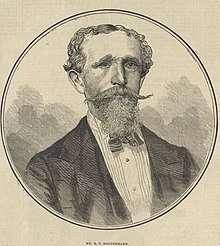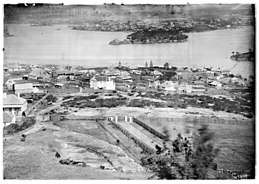Bernhardt Holtermann
Bernhardt Otto Holtermann (29 April 1838 – 29 April 1885[1][2]) was a successful gold miner, businessman, and politician in Australia. Perhaps his greatest claim to fame is his association with the Holtermann Nugget, the largest gold specimen ever found, 59 inches (1.5 m) long, weighing 630 pounds (290 kg), in Hill End, near Bathurst,[1] and with an estimated gold content of 3,000 troy ounces (93 kg).[3]
Bernhardt Otto Holtermann | |
|---|---|
.jpg) Holtermann and the gold specimen discovered at Star of Hope Mine in 1872 | |
| Born | 29 April 1838 |
| Died | 29 April 1885 (aged 47) |
| Resting place | St Thomas's Cemetery |
| Occupation | gold miner, businessman, and politician |
| Spouse(s) | Harriet Emmett |
| Children | (unnamed male) Holterman (1869–?), Harriet Esther Holtermann (1873–1901), Bernard Edward Henry John Holtermann (1875–1875), Burlington Otto Holtermann (1876–1897), Sydney Hermann O. Holtermann (1879–1956), St Leonard Leichardt Ratchford Holterman (1882–1950) |
| Relatives | Hugo Louis Beyers (husband of sister-in-law and business partner) |
Early life
Holtermann was born in Hamburg, Germany. He emigrated in 1858 to avoid Prussian military service.[1][4] He departed Liverpool aboard the ship Salem and reached Melbourne in August after a journey lasting 101 days.[5]
Mining
After working at a variety of jobs, he teamed up with Ludwig Hugo 'Louis' Beyers. They began prospecting around Hill End, New South Wales. Years of unrewarding labour followed. On 22 February 1868, Holtermann married Harriett Emmett, while Beyers married her sister Mary.
In 1871, the Star of Hope Gold Mining Company, in which he and Beyers were among the partners, struck rich veins of gold. On 19 October 1872, the Holtermann Nugget was discovered. Not strictly speaking a nugget, it was a gold specimen, a mass of gold embedded in rock, in this case quartz.[3] Holtermann attempted to buy the 3,000 troy ounces (93 kilograms) specimen from the company, offering £1000 over its estimated value of £12,000[6][7] (about AU$1.9 million in 2016 currency, AU$4.8 million on the 2017 gold price), but was turned down, and it was sent away to have the gold extracted.[5] Disheartened, he resigned from the company in February 1873.[5]
When the Hill End Borough Council was constituted on 6 August 1873, Holtermann was elected as an Alderman of the first council.[8] In October 1874, Holtermann was elected an Alderman in a special election for the Belmore Ward of the Borough of St Leonards.[9]
Later life

He built a large mansion, "The Towers" in North Sydney, complete with a stained glass window depicting himself and the specimen. Located at a panoramic location near Blue and William streets, he resided there until his death in 1885 and its site is now the Sydney Church of England Grammar School.[10] He invested wisely and kept his wealth, allowing him to take up his true passion of photography.[11]
Holtermann was also interested in patent medicine. He was proud of having cured fellow passengers on his 1858 sea voyage to Australia.[12] After he retired from mining, he wrote papers and devised formulae for medicines, and promoted and sold "Holtermann's Life Preserving Drops".[2][12]
In 1882, on his third try, Holtermann was elected to the New South Wales Legislative Assembly for St Leonards, which he served until his death.[13]
He died in Sydney, Australia on his birthday, 29 April 1885, of "cancer of the stomach, cirrhosis of the liver and dropsy",[12] leaving a wife, three sons, and two daughters.[1]
Photography

Holtermann financed and possibly participated in Beaufoy Merlin's project to photograph New South Wales and exhibit the results abroad to encourage immigration. The work was taken up after Merlin's death in 1873 by his assistant, Charles Bayliss. In 1875, Holtermann and Bayliss produced the Holtermann panorama, a series of "23 albumen silver photographs which join together to form a continuous 978-centimetre view of Sydney Harbour and its suburbs."[14] Some of the photographs, including the panorama, were displayed at the Philadelphia Centennial Exhibition, where they won a bronze medal.[14] The panorama was also displayed at the 1878 Exposition Universelle Internationale in Paris.[14]
Almost seventy years after Holtermann's death, more than 3,000 of the glass negatives created by Merlin and Bayliss were retrieved from a garden shed in the Sydney suburb of Chatswood. The UNESCO-listed collection of negatives, known as The Holtermann Collection, is housed in the State Library of New South Wales[15] and presented in Gulgong Holtermann Museum.
Literature
- Hein, Christoph: Australia 1872. How Bernhard Holtermann turned gold into a unique photographic treasure, Emons Verlag, Cologne 2020, ISBN 978-37408-0841-9
References
-Colorized.jpg)
- Burke, Keast (1972). "Holtermann, Bernhardt Otto (1838–1885)". Australian Dictionary of Biography. 4. Melbourne University Press. ISSN 1833-7538. Retrieved 13 April 2013 – via National Centre of Biography, Australian National University.
- "Holtermann, Bernhardt Otto (1838 - 1885)". Encyclopedia of Australian Science. Retrieved 2 June 2012.
- "Famous Gold Nuggets: The Beyers and Holtermann Nugget". Archived from the original on 22 April 2009. Retrieved 18 January 2010.CS1 maint: BOT: original-url status unknown (link)
- "Bernhardt Otto Holtermann". Goethe-Institut Australien. Retrieved 18 January 2010.
- Carl Fredrik Holtermann (Summer 2008). "The Holtermann Gold". Cabinet Magazine. Retrieved 2 June 2012.
- "Death of Mr. Henry King". National Advocate. Bathurst, NSW. 18 March 1915. p. 3. Retrieved 25 August 2016.
- "Gold Mining Statistics". Bendigo Advertiser. 24 May 1871. p. 3. Retrieved 25 August 2016.
- "2460: Hill End Borough Council". Record Agency. NSW State Archives & Records. Retrieved 8 December 2017.
- "BOROUGH OF ST. LEONARDS". New South Wales Government Gazette (232). New South Wales, Australia. 9 October 1874. p. 3043. Retrieved 16 April 2019 – via National Library of Australia.
- "'THE TOWERS' NEAR BLUE AND WILLIAM STREET, NORTH SYDNEY (DEMOLISHED)". At Home in North Sydney. North Sydney Council. Retrieved 8 December 2017.
- "Famous Germans in Sydney". Dictionary of Sydney. Retrieved 18 January 2010.
- "Hill End Dispensary, 1872". State Library of New South Wales. Retrieved 2 June 2012.
- "Mr Bernard Otto Holtermann (1838-1885)". Former Members of the Parliament of New South Wales. Retrieved 5 May 2019.
- "Holtermann panorama" (PDF). National Gallery of Australia. Retrieved 18 January 2010.
- "Holtermann Collection now digitised" (PDF). SL Magazine. 4 (2): 30. Winter 2011.
External links
- The Holtermann Collection Story at the State Library of New South Wales
- The Holtermann Collection of glass plate negatives at the State Library of New South Wales
- The Greatest Wonder of the World (Exhibition), (23 Feb 2013 – 12 May 2013), State Library of New South Wales
| New South Wales Legislative Assembly | ||
|---|---|---|
| Preceded by James Farnell |
Member for St Leonards 1882–1885 With: Dibbs |
Succeeded by Isaac Ives |